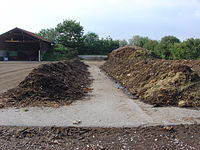
Photo from wikipedia
Abstract In this study, effect of waste tire (WT) addition to cotton stalk (CS) pyrolysis is investigated with a focus on liquid co-pyrolysis yield quantity and quality. Various blend ratios… Click to show full abstract
Abstract In this study, effect of waste tire (WT) addition to cotton stalk (CS) pyrolysis is investigated with a focus on liquid co-pyrolysis yield quantity and quality. Various blend ratios (i.e. CS/WT 1:0, 4:1, 3:2, 2:3, 0:1) of the two feedstocks were experimented in a fixed bed reactor at 20 °C/min heating ramp rate up to 550 °C with 50 ml/min flowrate of nitrogen as sweeping gas. Blend ratio CS/WT (2:3) showed maximum oil yield (48 wt%) with organic phase (OP) above 78 wt% of the total liquid yield (OP + aqueous phase, AP). OP of CS/WT (2:3) along with those of CS/WT (1:0) and (0:1) were further analyzed qualitatively using analytical techniques including, FTIR, GC-MS, bomb calorimetry and elemental analyzer. Significant increase in carbon and decrease in oxygen content of the CS/WT (2:3) pyrolytic oil was observed which improved its calorific value to 41 MJ/kg. Among the three OP samples, only CS/WT (2:3) oil showed significant presence of alkanes in GC-MS results, which is, thus, associated with the synergistic effect of the co-pyrolysis process. Addition of WT to CS pyrolysis feedstock improved liquid yield and its quality, thus requiring lesser further processing for its commercial use as compared to that of CS/WT (1:0) oil.
Journal Title: Renewable Energy
Year Published: 2019
Link to full text (if available)
Share on Social Media: Sign Up to like & get
recommendations!